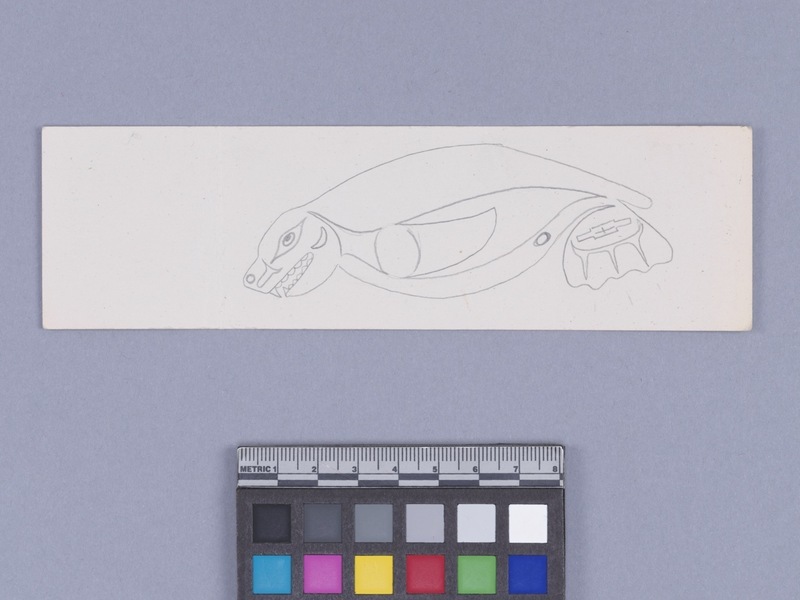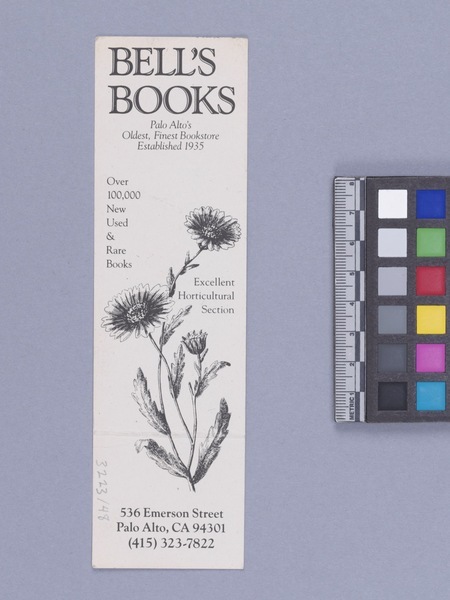Drawing Item Number: 3223/48 from the MOA: University of British Columbia


Description
A pencil drawing on a light beige bookmark. The front-side of the bookmark is a horizontally oriented, hand-drawn image of a sea lion(?) in profile. The sea lion is outlined in pencil with the interior remaining light beige. The eye is surrounded by a diamond-shaped patch; a wide tower-shape is drawn on the snout between the eye and the nose. The mouth is lined with two canine teeth and rounded molars; to the right of the mouth is a crescent-shape. The front flipper extends from the base of the head to the midsection; two curving lines embellish the flipper. A small oval is drawn towards the hind flipper on the underbelly. The hind flipper is decorated with three interconnected tower-shapes forming grooves on the flipper. The reverse-side of the bookmark is vertically oriented, and is machine-printed in black ink. At the top is the bookstore's name, "Bell's Books;" below, lines of text describe the store's specialties. Extending from the centre to the bottom of the bookmark, is an image of three daisy-like flowers. The bookstore's commercial information is printed at the very bottom.
History Of Use
These 62 small works (3223/1-62) comprise a collection of drawings in pencil, ink, pencil crayon, and felt pen made by the artist between the years 1968 and 2015. During that period the artist has identified himself by the following names: Ron Hamilton; Hupquatchew; Ki-ke-in; Kwayatsapalth; Chuuchkamalthnii; and Haa’yuups. The drawings are, for the most part, applied to the backs of bookmarks acquired from a range of bookshops; some are applied to other pieces of paper or cutouts from his earlier silkscreen prints. Many of the images represent killer whales, often in conjunction with accoutrements and symbols of Nuu-chah-nulth whaling. The juxtaposition of bookmark and representation of Nuu-chah-nulth himwits’a, or narrative, is a deliberate and meaningful placement of two distinct knowledge systems in relationship with one another. Ephemeral drawings like these were not created for the market; the artist has long made them for himself and sometimes as gifts for relatives and friends; they are a way of sharing his knowledge and experience about Nuu-chah-nulth ways of knowing, thinking about, and being in this world; they are expressive of what he calls kiitskiitsa: marks made with intention.
Item History
- Made by Ron Hamilton (Maker) in British Columbia, Canada between 1968 and 2015
- Owned by Ron Hamilton before November 8, 2016
- Received from Museum of Anthropology Acquisitions Budget (Funding source), Michael O'Brian Family Foundation (Funding source) and Ron Hamilton (Seller) on November 18, 2016
What
- Name
- Drawing
- Identification Number
- 3223/48
- Type of Item
- drawing
- Overall
- height 5.0 cm, width 17.7 cm
Who
- Culture
- Nuu-chah-nulth: Hupacasath
- Creator
- Ron Hamilton (Maker)
- Previous Owner
- Ron Hamilton
- Received from
- Museum of Anthropology Acquisitions Budget (Funding source), Michael O'Brian Family Foundation (Funding source) and Ron Hamilton (Seller)
Where
- Holding Institution
- MOA: University of British Columbia
- Made in
- British Columbia, Canada
When
- Creation Date
- between 1968 and 2015
- Ownership Date
- before November 8, 2016
- Acquisition Date
- on November 18, 2016
Other
- Item Classes
- works on paper
- Condition
- fair
- Current Location
- Case 9
- Accession Number
- 3223/0048